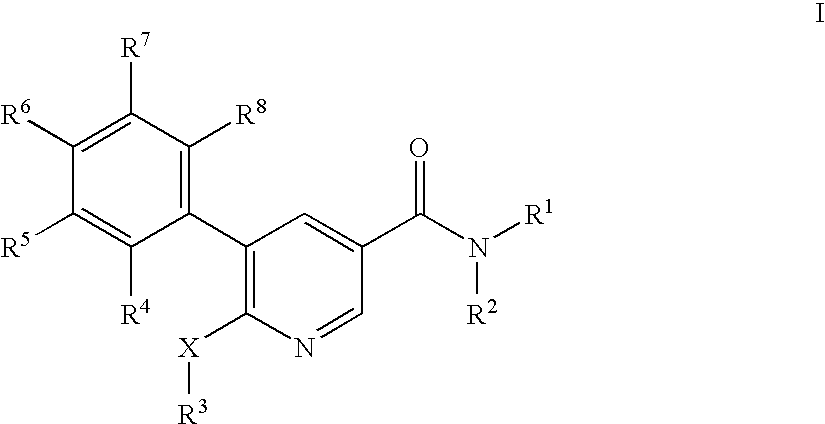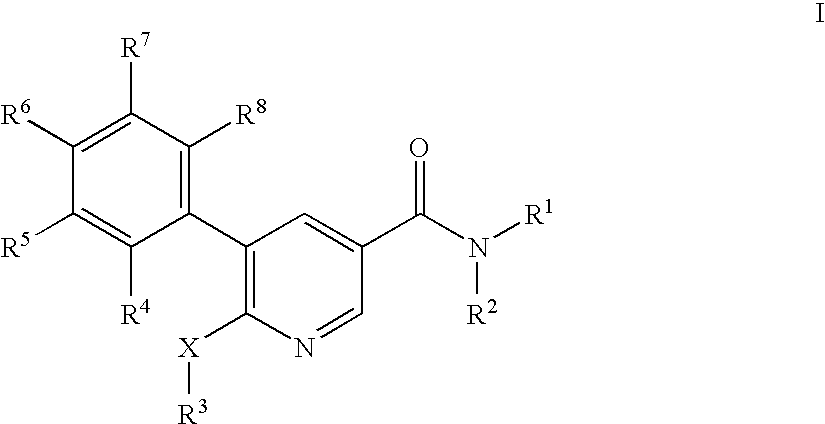Pyridine-3-carboxamide derivatives as CB1 inverse agonists
a technology of pyridine and carboxamide, applied in the field of 3pyridinecarboxamide derivatives, can solve problems such as the association of defective leptin signaling
- Summary
- Abstract
- Description
- Claims
- Application Information
AI Technical Summary
Problems solved by technology
Method used
Image
Examples
example 1
5-(2-Chloro-5-trifluoromethyl-phenyl)-6-cyclopentyloxy-N-((1R,2R)-2-hydroxy-cyclohexyl)-nicotinamide
5-Bromo-1,6-dihydro-6-oxo-3-pyridinecarboxylic acid
[0390]To a suspension of 1,6-dihydro-6-oxo-pyridinecarboxylic acid (40 g, 288 mmol) in acetic acid (75 mL) bromine (69 g, 431 mmol) is added dropwise with stirring. The temperature increased to 45° C. and the mixture was stirred overnight at 50° C. The reaction mixture was concentrated in vacuo and the crude residue of 5-bromo-1,6-dihydro-6-oxo-3-pyridinecarboxylic acid was used in the next step without purification.
5-Bromo-6-chloro-3-pyridinecarboxylic acid methyl ester
[0391]To 63 g of the previous crude material was added with mechanical stirring phosphorus oxychloride (75 mL) and then phosphorus pentachloride (120 g) in portions so that the temperature did not rise above 30° C. The mixture was stirred overnight at 95° C. and concentrated in vacuo. The residue was dissolved in dichloromethane (150 mL) and methanol (150 mL) was added...
example 2
6-Butoxy-5-(2-fluoro-5-trifluoromethyl-phenyl)-N-((1R,2R)-2-hydroxy-cyclohexyl)-nicotinamide
3-Bromo-5-methyl-2(1H)-pyridinone
[0396]5-Methyl-2(1H)-pyridinone (50 g, 0.46 mol) was suspended in dichloromethane (500 mL). N-bromosuccinimide (82 g, 0.46 mol) was added in portions with cooling. Addition was finished after 15 min; the mixture was stirred for 1 h at room temperature and afterwards partitioned between dichloromethane and water. Organic phases were pooled, dried with Na2SO4 and the solvent was evaporated. The residue was purified by crystallization from ethyl acetate to yield 55 g of the title compound as a light yellow solid, mp 156–161° C.
3-Bromo-2-chloro-5-methyl-pyridine
[0397]A mixture of 3-bromo-5-methyl-2(1H)-pyridinone (25 g, 0.13 mol) and phosphorus oxychloride (500 mL) was boiled with stirring for 20 h. Phosphorus oxychloride was removed by distillation and the residue was poured onto ice / water (800 mL). The mixture was adjusted to pH 8.5 with 2 N sodium hydroxide sol...
example 3
6-Butoxy-5-(4-chloro-phenyl)-N-((1R,2R)-2-hydroxy-cyclohexyl)-nicotinamide
[0402]The title compound was synthesized in analogy to Example 2, using 3-bromo-2-chloro-5-methyl-pyridine, 1-butanol, [4-chloro-phenyl]-boronic acid and (1R,2R)-2-amino-cyclohexanol as starting materials, MS (ISP) 403.2 (M+H)+.
PUM
| Property | Measurement | Unit |
|---|---|---|
| body weight | aaaaa | aaaaa |
| body weight | aaaaa | aaaaa |
| temperature | aaaaa | aaaaa |
Abstract
Description
Claims
Application Information
 Login to View More
Login to View More - R&D
- Intellectual Property
- Life Sciences
- Materials
- Tech Scout
- Unparalleled Data Quality
- Higher Quality Content
- 60% Fewer Hallucinations
Browse by: Latest US Patents, China's latest patents, Technical Efficacy Thesaurus, Application Domain, Technology Topic, Popular Technical Reports.
© 2025 PatSnap. All rights reserved.Legal|Privacy policy|Modern Slavery Act Transparency Statement|Sitemap|About US| Contact US: help@patsnap.com



